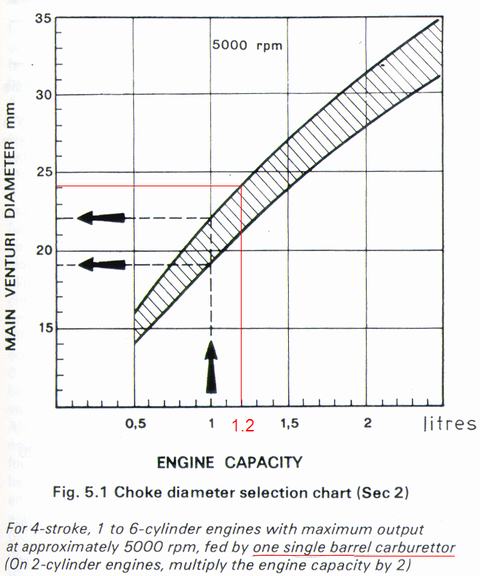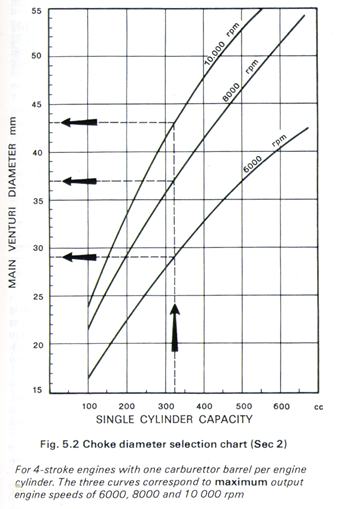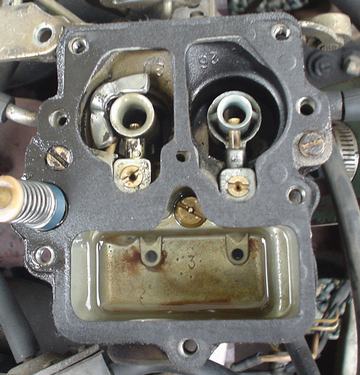Proper carburetor sizing is important for good performance. For maximum power, consult the carburetor manufacturer's recommendations. For good power and great street flexibility, choose a slightly smaller size. Flexibility means smooth action at all RPM ranges and throttle openings (off-idle, part throttle and full throttle).
Contents |
General Sizing Guidelines
For a stock A12 engine (max power at 6000 RPM), choose:
- Single-bore carburetor: 26mm venturi
- Dual 2-choke carbs: 28mm venturis
- Progessive carb: 22 & 26 mm venturis
The carburetor size -- and more specifically, the venturi (choke) size -- is dependent on the type of inlet manifold being used.
Or course for a modified A12 engine with higher RPM range than stock, say for 6,000-8,000 rpm max power, you'd want bigger venturis.
Remember that the theoretical size is just a starting point. Actual test driving or dyno runs will show if slightly bigger or smaller is desired. It depends on what you want: more peak HP at the expense of partial throttle response and low-speed operation, or the reverse. Note the the charts will indicate a range of size (the shaded area), but you could go outside that if you wanted to enhance flat-out acceleration and don't care about off-idle performance (example: fitting a DGV Weber 32/36 to a stock A12).
Plenum Manifold
From this chart from the weber book, we see discern what sizes to use. For a 1200cc engine at 6000 rpm it looks like a 26mm secondary venturi is called for, based on this chart and interpolating for 6000 rpm. Looking at Nissan's A12 specs, it seems Nissan used the same logic:
- A12 secondary venturi: 26 mm
NOTE: This chart is for "single carburetor" feeding all the cylinders (i.e. using a plenum). For one-barrel per cylinder (example: dual DCOEs on a four cylinder with invididual inlet runners) see the other chart.
According to the fine text below this chart:
- It doesn't matter if it's a 2-cylinder, 4-cylinder or 6-cylinder engine, Weber recommends to use the same size carburetor.
- "2-cylinder" wordimg in the chart may be a typo. Did they mean "two-cycle"?
Invidual Runners
For a single carburetor barrel (bore) per cylinder, rather than multiple carbs or bore feeding all cylinder via a plenum, use this chart:
So for our stocker A12 engine (max power at 6000 RPM), choose 28mm venturis.
Progressive Carburetor
All Hitachi DCG306/DCH306 have barrel sizes of:
- 26/30
So they have much smaller barrels than the Weber 32/36.
According to the Nissan factory books:
- The A12 (and A12A) got venturis of 20/26.
- Most A14s are 23/27, but some were 22/27.
- A15s mostly use the 22/27, but Canadian A15s had 23/27.
You can look at the size of you carb, the numbers appear as is this photo. You can shine a flashlight down the air cleaner to see them:
This quotes helps to explain why Nissan gives small primary venturis to our A-series.
- A12 secondary venturi: 20 mm
the difference between the pimary and secondary choke diameters may need to be increased 1 mm or 2 mm in order to give more flexibility at the lower engine speeds.
the secondary choke [venturi] size can be determined from Fig. 5.1 and the primary choke size is normally 1 mm less.
20mm is a lot smaller than the book recommends, but then this road-going car has very good "flexibility at the lower engine speeds".
Note that most A14 carbs are have venturis of 23/27, so that would probably give a good performance boost for a stock A12, without sacrificing driveability.
From the text, it seems this chart applies to a "single carburetor" feeding all the cylinders (i.e. using a plenum), whether that carb is one or two barrels. So why a smaller primary? Well, the usual goal of a progressive carburetors is to give better low speed flexibility. The primary and secondarys will be matched on synchronized carbs like the Weber DGAS 38/38. I don't see why you couldn't do the same with a progressive carb. But if your goal is max performance, the synchronized carb (or carbs) is the usual choice.

![[Datsun 1200 encyclopedia]](/wiki/upload/wiki.png)


